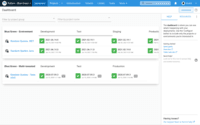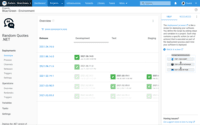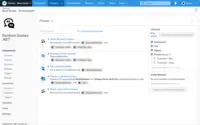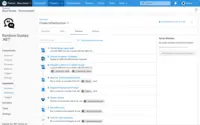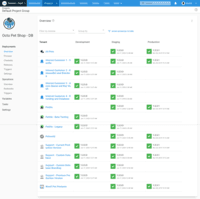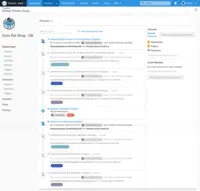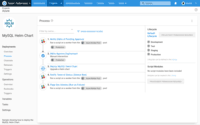Overview
What is Octopus Deploy?
Australian company Octopus Deploy offers their eponymous automated deployment and release management software that integrates with the user's preferred CI server and adds deployment & ops automation capabilities. Octopus Deploy enables developers, release managers, and operations folks to bring all…
Deployments made easy (and stress-free)
Octopus Deploy, I take my hat off to this product
Octopus Deploy, a real star in a sea of tough choices
Amazing tool that does everything you'd ever need just at a price you can't afford
Fantastic deployment solution
Simply a must-have for teams of any size
The DevOps Tool you need, even if you don't think you do.
Useful Automation tool
Octopus Deploy is a good Continuous Deployment tool
Octopus is a good value and very effective for .Net (legacy & core) applications
Octopus, with its many tentacles, maintains a tight grip on your deployment process
Used it for 4 Years, Excellent, Easy to learn, Easy to Manage/Maintain
Octopus Deploy - A Developer's Friend
Octopus Deploy meets all our deployment needs
Octopus Deploy overview
Awards
Products that are considered exceptional by their customers based on a variety of criteria win TrustRadius awards. Learn more about the types of TrustRadius awards to make the best purchase decision. More about TrustRadius Awards
Pricing
Cloud
Free 30 day trial
Server
Free 30 day trial
Enterprise
Starting at $18 per month
Entry-level set up fee?
- Setup fee optional
Offerings
- Free Trial
- Free/Freemium Version
- Premium Consulting/Integration Services
Starting price (does not include set up fee)
- $12 per month
Product Details
- About
- Integrations
- Competitors
- Tech Details
- FAQs
What is Octopus Deploy?
The Octopus Deploy platform enables developers, release managers, and operations teams to bring automation into a single place.
By reusing configuration variables, environment definition, API keys, connection strings, permissions, service principals, and automation logic, teams work together from a single platform. Octopus Deploy helps to break down silos and improve collaboration so teams can ship and operate software with greater confidence.
Octopus Deploy Screenshots
Octopus Deploy Video
Octopus Deploy Integrations
Octopus Deploy Competitors
Octopus Deploy Technical Details
| Deployment Types | On-premise, Software as a Service (SaaS), Cloud, or Web-Based |
|---|---|
| Operating Systems | Windows, Linux |
| Mobile Application | No |
| Supported Countries | Global |
| Supported Languages | English |
Frequently Asked Questions
Octopus Deploy Customer Size Distribution
| Consumers | 15% |
|---|---|
| Small Businesses (1-50 employees) | 20% |
| Mid-Size Companies (51-500 employees) | 40% |
| Enterprises (more than 500 employees) | 25% |
Comparisons
Compare with
Reviews and Ratings
(45)Community Insights
- Recommendations
Users have made several recommendations for Octopus Deploy based on their experiences.
One common recommendation is to take the time to learn the product and create clear deployment plans for each software. By familiarizing themselves with Octopus Deploy and carefully planning their deployments, users have been able to simplify and accelerate the deployment process for their applications.
Another recommendation is the effectiveness of Octopus Deploy in deploying binaries and files. Users have found this feature to be reliable and efficient in their deployment workflows, making it an attractive option for companies looking to automate their build process and improve their deployment workflows.
Additionally, users recommend using Octopus plugins with continuous integration servers like Jenkins or Teamcity to streamline the deployment process. By integrating Octopus Deploy with these tools, users have been able to further optimize their deployment workflows and enhance the overall efficiency of their software development processes.
Overall, these recommendations highlight Octopus Deploy's potential to simplify deployments, deploy files effectively, and integrate seamlessly with other tools to streamline the deployment process.
Attribute Ratings
Reviews
(1-14 of 14)Octopus Deploy, a real star in a sea of tough choices
- Octopus Deploy is versatile, if you can dream it you can do it!
- Octopus Deploy is very user-friendly; from the deployment plan to error reporting, I've always felt in control.
- Octopus Deploy has a generous free plan so you can easily try before you buy.
- Acquiring an instance to run on can take a long time, especially a Linux instance
- Containers are recommended but extremely slow
Amazing tool that does everything you'd ever need just at a price you can't afford
- Multiple deployments
- Version control
- Pricing structure
- UI is clunky when you have multiple sites in your infrastructure
- If deploying to single points in 1 area there's no way to represent this is the case and just shows as if everything was deployed to
The DevOps Tool you need, even if you don't think you do.
- Separating out environments, letting us create immutable artifacts which we promote from dev to staging to prod
- Bypassing tricky firewall configs by deploying polling tentacles inside the firewall
- Automating quirky or custom devops scenarios with relative ease
- A build of Tentacle for the M1 Mac (so I can test against my local machine)
- A full Python API wrapper
Useful Automation tool
- UI
- Release deployment
- Dashboard for reporting
Octopus Deploy is a good Continuous Deployment tool
- Fetch artifacts.
- Deploy to AWS environment.
- Deploy to Docker Container Clusters.
- Deploy to static website infrastructure like S3 and CloudFront.
- Octopus should have an easy to use IaC.
- .Net Code deployment
- Distributed Powershell scripting
- Config management
- Better Linux/*Nix support
- We have also used it to avoid "touching" servers for routine Powershell-automated tasks.
Octopus Deploy meets all our deployment needs
- Granular control over tenants for deployments using tags.
- UI makes it easy to train and onboard new team members.
- API documentation is great.
- We have not run into any limitations yet. Perhaps our use case is very simple.
Great tool to automate DevOps
- Automation of deployments
- Managing pipeline activities
- Requiring a consistency of process
- Improved reporting
- Additional out of the box integrations that work really really well.
- Onboarding and ramp-up may benefit from some AI, so it does not take so much experience to be an "expert."
- Integrates well with various platforms
- Allows customization of deployment process, manual deploys, and redeploys
- Allows flexible deployment process definition and scripting
- UI is very fluffy and padded. It looks pretty but it could benefit from a more compact, information-focused design
- Deployment process options are not always laid out in an intuitive manner. Choosing which steps to exclude, which environments or targets to deploy to, etc., is not immediately clear
- Lack of useful reports and metrics for tracking active deployments and historical data
- The ability to manage different stages and define a workflow is very useful for ops troubleshooting as well as deployment. You can see which version each environment has for each project, and promote or redeploy versions.
- You can view deployment logs and dig deep into problems or long deployment steps.
- Finding old releases can be a pain, and there isn't a good way to compare releases.
- It does not really lend itself well to viewing what the content of a release is further than the version number. Ideally, you would be able to tie a deployment to the builds from the build server as well as specific commits from source control.
Much simpler and safer implementations.
- Easy to use because it has a very simple and understandable interface.
- It offers different languages as well as several operating systems.
- Allows it to be implemented on own or third-party servers.
- Your support team is extremely attentive.
- Provides a very user-friendly documentation as it is easy to understand.
- The implementations can be carried out in an automated way thanks to the fact that it allows you to configure if you want to do it immediately or in the future.
- Its price can be high according to where you want to implement the applications.
- Your configuration may take some time so it is necessary to have a good knowledge in this field otherwise it will take more time than expected.
- Their integrations although they are very advantageous can be somewhat complicated.
Octopus Deploy - a great deployment automation tool with an awesome free plan and extensive integrations
- Octopus integrates nicely with TeamCity, our build server.
- Octopus uses the same deployment packages across environments and makes it easy to track their progress across those environments.
- Octopus makes it easy to handle configuration across environments which is usually a particularly difficult task.
- I would like to see Octopus handle branches as a first class citizen better. It certainly has branch support, but it is not as smooth or as intuitive as I would like it to be. I would like it to be easier to pick the branch of a repo I want to deploy and where I want to deploy it.
- I think Octopus could do more to help the management of Azure deployments. The ability to swap slots in Azure would be a welcome feature.
- Many different platforms, languages, and operating systems are supported. You can deploy to your own server or the cloud. You can deploy to Windows, Linux, etc.
- Many different "step templates" are included, which make it very easy to deploy what you want, how you want. Such as deploying over SSH, FTP, etc.
- Support is very responsive and personable. You won't just be talking to a robot or a script. They will either solve your problem or understand it enough to solve it in a future release.
- Their documentation is well thought-out and very helpful. I have found very few missing pieces.
- The pricing model is a bit strange. You can run Octopus Deploy yourself on your own server, or use their cloud service. Surprisingly, the cloud service can easily be less expensive. With self-hosting, pricing doesn't become less expensive with more deployment targets. Instead, it becomes more expensive.
- There are a few features they're aware of, that are not released yet, that would be huge improvements to the software. Such as "Spaces", which allows you to group projects/deployment targets/users. Otherwise at the moment, as you add more projects and infrastructure, the deployment portal quickly becomes cluttered.
- Payment was more difficult than expected. The company is located in Australia. Mailing a check is very slow from the US.
Focusing on Deployment with Octopus Deploy
- Octopus Deploy provides direct access to IIS App Pools, App Pool Permissions, Directory locations and more. Options are clearly displayed in the interface as opposed to searching out arcane switch statements for command line arguments or complex batch statements used with platforms focused on skills other than deployment tooling.
- Octopus Deploy works extremely well in conjunction with RedGate's ReadyRoll database lifecyle management tool with the same level of configuration capabilities for RedGate's database deployment configuration as for other deployment targets.
- Octopus Deploy agents are generally easy to configure and record a plethora of information about the deployment process and any errors in the deployment process itself.
- Octopus Deploy automatically generates encrypted connections between the Octopus Deploy server and Tentacles ensuring communication between Octopus Deploy and target machines is secure by default. I give customers Octopus Deploy documentation as the first step to allaying security concerns and often find no further discussions are required.
- I prefer VSTS Agent's https "Pull" configuration to Octopus Deploy's "Push". Because VSTS remote agents pull information from Visual Studio Team Services via https, no firewall rules are required when deploying the agents. Octopus Deploy agents typically are configured to be polled from the central Octopus Deploy server and must have firewall rules configured to allow conversations.
- Octopus Deploy's Pipeline configuration can get a bit complex and is sometimes less than intuitive when configuring deployments across multiple environments. While it is possible to use variables to simplify configurations, examples are not readily available and the process for configuring and using variables is not as easy to understand as I would like.
- Deployments are not more error-prone because there is no manual intervention. There had been cases in the past where a thing or two miss would cause a lot of heartburn during Prod release and we had to keep the whole herd together until everything was sorted out. With Octopus Deploy we can test the release with the repeat-ability and chances of running into issues has been minimized a lot.
- Octopus Deploy works really well with the whole stack of Microsoft Products. It was one of the 1st 3rd party tools for Continuous Deployment focused on MS products when it was initially released. Over time, however, it has matured and supports nearly every technology under the sun for implementing automated deployments.
- More frequent and parallel deployments. This is where Octopus really shines. This ensures that the QA team is constantly engaged and not waiting for the Dev team as releases are promoted to Test environments faster and ultimately helps to move new features/bug fixes to Prod faster thereby delivering tremendous business value and puts us in a good light in front of our consumers.
- The tool has a very nice GUI and supports scripting in Powershell, C#, Bash, F#. The Octopus user community has developed close to 80 templates that can be used readily. Octopus works as seamlessly on the Cloud as it works on premises. It has first-class support for both AWS and Azure.
- Support for non-Microsoft applications needs to be improved to bring it on par with other comparable automation tools.
- It doesn't yet provide integration options with other IT management tools like JIRA and HP Support to implement continuous delivery and true DevOps processes.
- Support for AWS/Azure has been included very recently and it's not still very mature and feature rich and is expected to improve further in upcoming releases.

